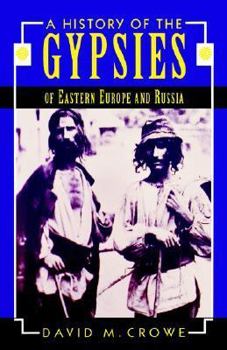A History of the Gypsies of Eastern Europe and Russia
Select Format
Select Condition 
Book Overview
In this fully updated edition with a new foreword by Andre Liebich, David M. Crowe provides an overview of the life, history, and culture of the Gypsies, or Roma, from their entrance into the region... This description may be from another edition of this product.
Format:Paperback
Language:English
ISBN:0312129467
ISBN13:9780312129460
Release Date:January 1996
Publisher:Palgrave MacMillan
Length:336 Pages
Weight:0.85 lbs.
Dimensions:0.9" x 5.5" x 8.3"
Customer Reviews
4 ratings
Historic European and Nazi Intolerance Examined
Published by Thriftbooks.com User , 15 years ago
This is an excellent overview and introduction to the traumatic history of the Gypsy, or Roma, population. This volume is more of a demographic study than an anthropological examination of Gypsy beliefs, culture, or spirituality. Sadly, many of the exhaustive and extensive sources that the author translated contain racist aspersions and ugly stereotypes of the Gypsies. The Roma were actually bought and sold as slaves throughout Eastern Europe and Russia, and even churches participated in this, as these refugees, originally from Northern India, were viewed complete outsiders, damned. If there was ever a people who suffered at least as badly for centuries as Jews did in these countries before, during, and after World War II, it was this population, which Crowe exhaustively documents here. This book is a good source for initial research, and as a way to access obscure and previously untranslated materials. For scholars, or someone who shares Gypsy heritage, like myself, researching this culture, heritage, and belief systems from the inside, this is a good and necessary beginning.
An amazing history
Published by Thriftbooks.com User , 16 years ago
This fascinating survey of the Gypsies of Eastern Europe and Russia offers histories of all the important communities in the East including in Bulgaria, Czechslovakia, Hungary, Rumania, Russia and Yugoslavia. Obviously other Gypsy communities are left out, such as those in Greece, Albania and Turkey. But such is life, the book stands alone nonetheless. Each chapter is a veritable encyclopedia of Gypsy life. For instance on Bulgaria the book describes how Gypsy women refused to don the Muslim veil forced upon Muslim women after the Turkish colonization of Eastern Europe. The book is packed full of data and demographics. For instance we learn that in 1910 there were 120,000 Roma listed on the census and in 1930 the estimate was 140,000. Muslim Gypsies were forcibly expelled from Bulgaria after the war. The book details the various anti-Gypsy laws that existed from Turkish times to the era of fascism and Communism. Usually disguised as `anti-nomadism' laws the target was obvious. In Czechslovakia the Roma worked as castle musicians and metal workers in the 16th century. In 1780 there were 43,000 Roma in Slovakia. In addition the Gypsys of Slovakia survived the war because of the intervention of the Slovak leader Jozef Tiso and his desire, despite being an ally of Hitler, to have his country free of Nazism. Roma in enighbouring lands were not so luck and the Holocaust destroyed many communities. In Rumania, long home to one of the largest concentrations of Roma they totaled according to estimates almost half a million or 2% of the population in 1977. In 1992 some claimed there were 2.2 million Gypsies a total of 10% of the population of the country. In Yugoslavia the Gypsies were part of a patchwork of nationalities that hated one another. One time they were viewed by Serbs in the 1920s as being allied to the Muslim Albanians but later the reverse would happen when the Croatian Ustasha Nazi collaborator Catholic government would exterminate the Gypsy population of Croatia and after the Nato `liberation' of Kosovo the same would happen in 1999 when Muslim Albanians cleansed the land of Gypsies (there had been 14,000 in Kosovo in 1971). In Macedonia the largest Gypsy community was constructed in the 1960s called Suto Orizari. In 1991 there were 200,000 Roma in Macedonia. This is simply a fascinating book that anyone with an interest in minorities, European history of Gypsies should get. One unfortunate fact: the book does not mention if there were any contacts between Gypsy communities and Jewish ones. Seth J. Frantzman
Wonderful history of Eastern Europe Roma
Published by Thriftbooks.com User , 21 years ago
Though for my research this book was a bit slim (dealing in pre-1600's) this book is wonderful for anyone interested in the Roma people who populate Eastern Europe. Dealing with both the beautiful and the ugly side of human nature, this book captures how the Roma live and have lived in Eastern Europe and Russia throughout history.
Outstanding must read book.
Published by Thriftbooks.com User , 25 years ago
This book is the most comperhensive work on Gypsies today. Anyone intrested in Gypsies and their origins should check this out.





